8 Origins and the Universe
Formative Assessment: Timeline of the Universe

The Big Bang: Origins of our Universe
The Big Bang is the best-supported scientific theory for how the universe was created. 13.7 billion years ago there was nothing and nowhere. Everything that ever existed was contained in a subatomic particle that was billions of times smaller than an atom. Within a fraction of a second, this amazingly tiny particle stretched and inflated to an unimaginably huge size. Space, time, and the fundamental particles of the universe were created in this instant.
Key Takeaway
Although the word “bang” is part of the name, the Big Bang was an expansion or an inflation rather than an explosion.
Although there are alternate theories, the Big Bang theory is supported by multiple sources of scientific evidence.
- Edwin Hubble discovered that the universe is still expanding today. If it is constantly expanding and growing now, that means it was smaller before–and likely the size of an unimaginably small particle at the beginning.
- Scientists detected Cosmic Microwave Background, a type of radiation that is present everywhere in the universe. Evidence suggests that this is leftover radiation from the energy of the Big Bang.
For more explanation of the Big Bang theory, watch the following video.
Video credit: “Big Bang Introduction” by Khan Academy is licensed under CC BY-NC-SA 3.0. Note: All Khan Academy content is available for free at khanacademy.org.
The Life Cycle of Stars
All stars begin their lives as clouds of gas and dust which are called nebulae. The particles in a nebula start to attract, so their combined mass increases. Therefore, they have more gravity which pulls in even more particles. Eventually, there will be enough particles under intense heat and pressure in the center core and nuclear fusion can occur. The star ignites and becomes a fully functioning star.
The image, below, shows the life cycles of different types of stars.
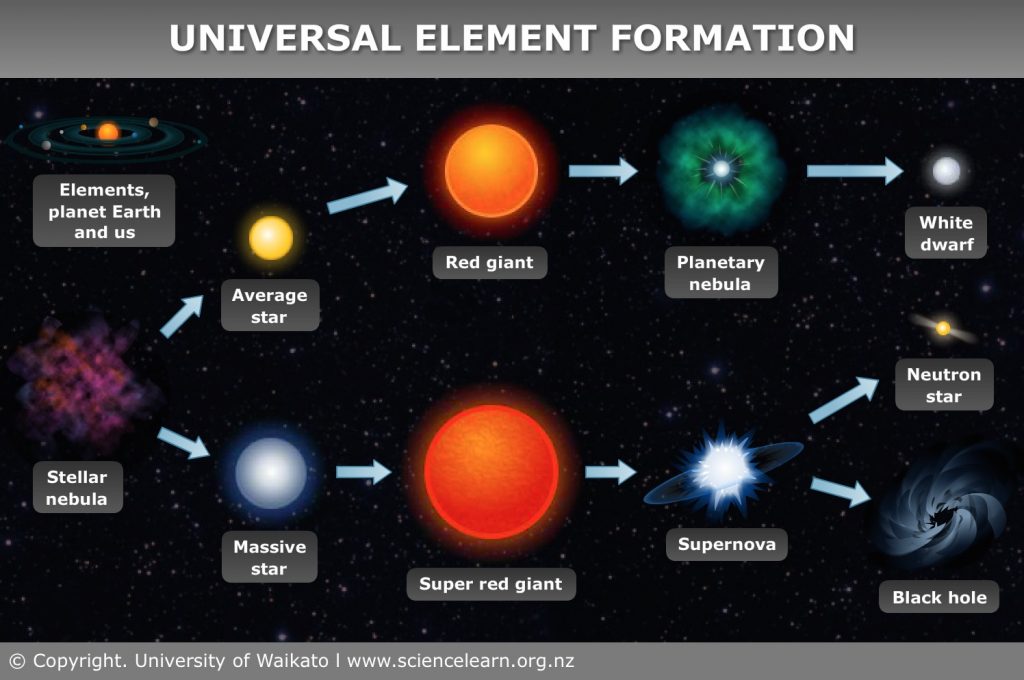
Depending on the amount of material in the nebula, an average star (like the Sun) or a supermassive star is formed. As the star burns through its fuel, it loses mass; therefore, it has less gravity and its size increases. An average star turns into a red giant. As it continues burning fuel, the red giant becomes very large. Then, the outer layers are blown off creating a planetary nebula and the inner core of the star remains, called a white dwarf star.
A supermassive star turns into a super red giant. These stars have more mass so they burn through their fuel more quickly, therefore losing gravity and becoming extremely large. Eventually, the super red giant will run out of fuel, collapse in on itself, and create a giant explosion called a supernova. From there, the star can either form a black hole or an extremely compact neutron star.
Interesting Fact: We Are Made of Stardust
- Nuclear fusion in stars begins with hydrogen atoms which fuse together to make helium. Eventually, the reactions increase and atoms continue fusing into different elements; stars can fuse all of the elements up to iron on the periodic table.
- When the dust and debris from a star is blown away in a planetary nebula or supernova, all of these elements scatter into space where they will become the basis for all new stars and matter in the universe. Therefore, we are made of stardust.
Origins of the Sun, Earth, and Moon
Our solar system was most likely formed from a giant rotating nebula after a former star underwent a supernova. 4.65 billion years ago, this rotation and intense gravity caused the nebula to collapse on itself. This caused it to spin faster and flatten into a disk shape, the Plane of the Ecliptic. Much of this material was pulled toward the center of the disk and a star was formed: the Sun. The Sun contains 99.8% of the mass in our solar system.
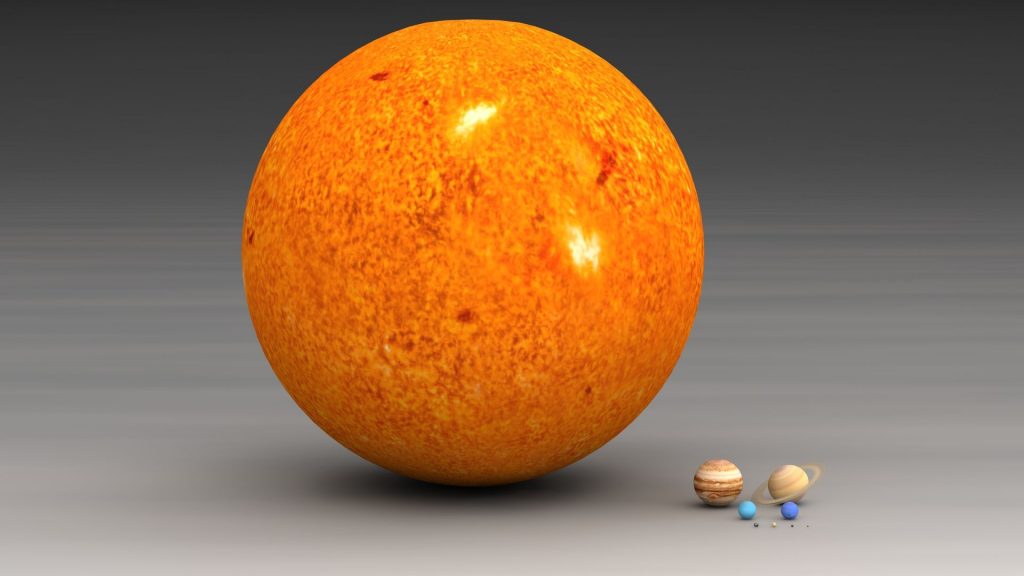
Although it is enormous compared to the size of Earth, the Sun is an average-sized star. It is mostly made of hydrogen and helium. Currently, it is halfway through its fuel supply. In around 5-6 billion years, the Sun will burn all of its fuel and become a white dwarf star.
After the Plane of the Ecliptic was formed, the planets formed from the leftover gas and dust orbiting around the Sun. One theory says that when the Sun turned on and became a star, the force of its energy blew off the gas clouds around the four inner planets which is why they are rocky and the outer planets are gaseous. Earth, a rocky planet, is about 4.65 billion years old. Scientists believe that life on Earth appeared approximately 3.5 billion years ago, based on evidence found in fossils.
For more detail of how space dust turns into planets, watch the video below:
Video credit: “The Dust Bunnies That Build Our Planet” by Lorin Swint Matthews/TED-Ed is licensed under CC BY-NC-ND 4.0
Key Takeaway
Earth was NOT formed during the Big Bang.
- The Big Bang occurred 13.7 billion years ago.
- Earth was formed 4.65 billion years ago.
- This means there is a lapse of 9 billion years between the Big Bang and the formation of Earth.
The Moon was formed when a Mars-sized object named Theia collided with the Earth. Early in its creation, Earth was molten. When it collided with Theia, chunks of Earth’s crust were ejected into space. Gravity bounded these pieces together and the Moon was formed, eventually cooling and hardening into its current rocky state. Evidence which supports this theory include that the Moon and Earth have very similar composition including an iron core, mantle, and crust, although the Moon is less dense since it was formed from lighter elements in Earth’s crust. The Moon is held to Earth by gravity and it is Earth’s only natural satellite object, although the distance between them is increasing by about 1.6 inches per year.
Characteristics of the Moon
- Distance from Earth: 239,000 miles
- Size: As seen in the image, below, the Moon is about 1/4 the size of Earth.
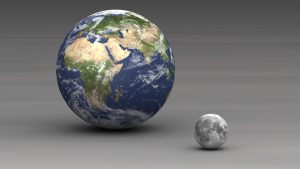
Own work is licensed under CC BY-SA 3.0.
- Composition:
- Surface: The Moon’s rocky surface is covered in dormant volcanoes and craters which are the results of impacts from meteorites and asteroids over billions of years. The Moon is covered with craters for two reasons:
- It does not have an atmosphere to protect it from the impact of objects such as asteroids in space.
- There is no wind on the Moon to erode existing craters.
- Climate: The Moon has no atmosphere, wind, or weather. Thus, the temperature can range from extremely hot to extremely cold since there is no atmosphere to protect it from the Sun’s heat or insulate the surface.
- Gravity: Remember, more mass=more gravity and less mass=less gravity. As such, the Moon has 1/6 of the gravity of Earth. This means if you weigh 60 lbs on Earth, you would weigh 10 lbs on the Moon.
- The Moon’s gravity, although weaker than Earth’s gravity, has enough pull to move water. This is what causes tides on Earth. As Earth rotates on its axis, the area on the near side of the Moon feels its gravity. As seen in the image below, this causes the water on that side–as well as the opposite side of Earth–to bulge out and create a high tide. As Earth continues to rotate, the gravitational pull weakens and the water recedes, creating a low tide. Since Earth completes one full rotation on its axis each day, most areas have two high tides and two low tides per day.
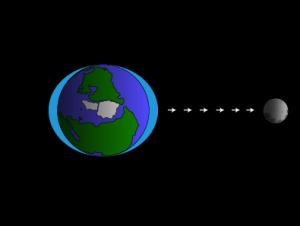
Sides of the Moon
There are two sides of the moon: the near side (the side we can see from Earth) and the far side (also known as the dark side). The Moon does not create its own light; it gets light from the Sun. As such, the dark side is not actually dark–it is just called the dark side because we cannot see it from Earth.

Since Earth has a larger mass, it exerts a stronger gravitational pull on the Moon. Earth’s pull controls the Moon’s orbit so that the Moon rotates once on its axis in the same amount of time it takes to orbit Earth. Therefore, the same side of the Moon is always facing Earth and we have a near side and a dark side. This effect is called tidal locking.
Click this link to see an animation of how tidal locking works as the Moon orbits Earth.
| Nearside of the Moon | Farside of the Moon |
|
|
|
|
|
|
Galaxies
A galaxy is a collection of billions of stars, gas, and dust held together by gravity in space. Using the Hubble Space Telescope, scientists can take images of space. In one small area, called the eXtreme Deep Field or XDF (image below) each of the bright spots is an entire galaxy–there are 5,550 galaxies within the image. There are probably 100 hundred billion galaxies in the entire universe.
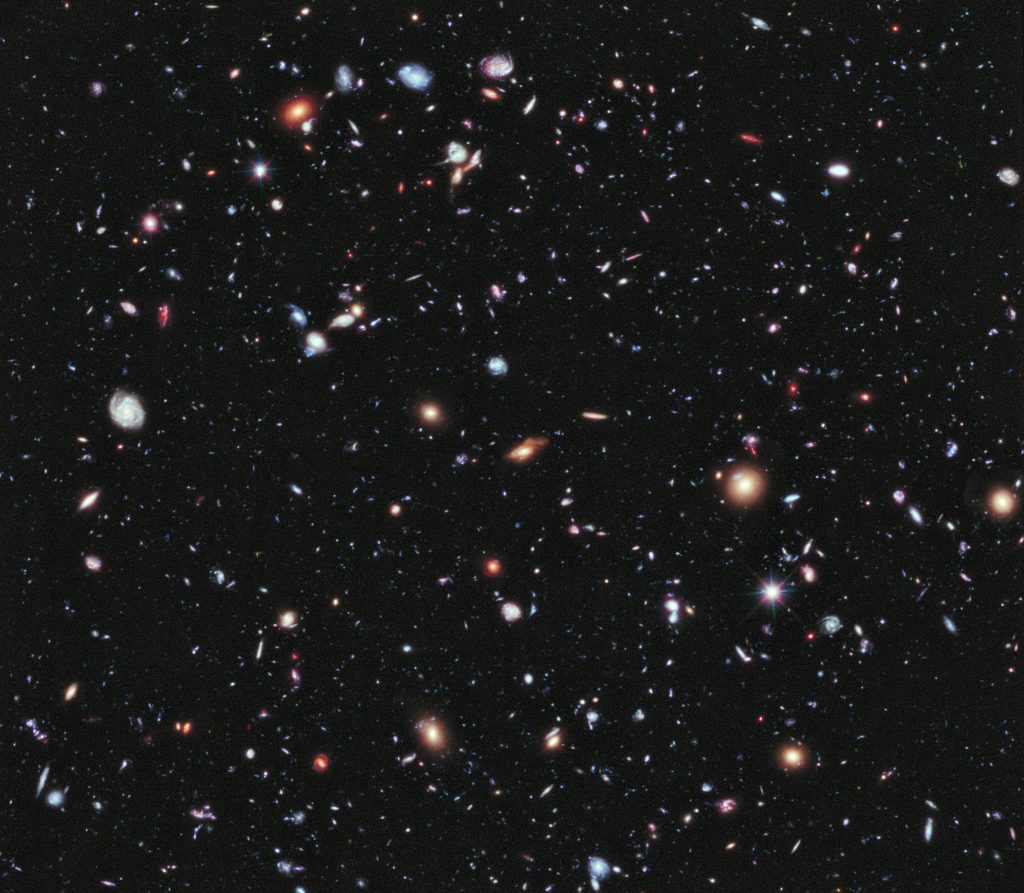
The Milky Way
A galaxy is a collection of billions of stars, gas, and dust held together by gravity in space. Our solar system is located in the Milky Way Galaxy. As seen in the image, below, it got its name because it appears as a milky band of light in the sky.

“La Silla Dawn Kisses the Milky Way” by ESO/B. Tafreshi is licensed under CC BY 4.0
As seen in the image, below, the Milky Way is a large spiral-shaped galaxy which contains hundreds of billions of stars. At the center of the Milky Way is a supermassive black hole named Sagittarius A which has a mass of 4 million suns. Our Sun, Earth, and all the planets are located halfway between the center and the outer edge on a small partial arm called the Orion Spur.

As seen in the image, below, there are 3 shapes of galaxies: spiral, elliptical, and irregular. Our galaxy, the Milky Way, is a spiral galaxy. Most galaxies have a supermassive black hole at the center which has an extremely strong gravitational pull that holds the entire galaxy together.
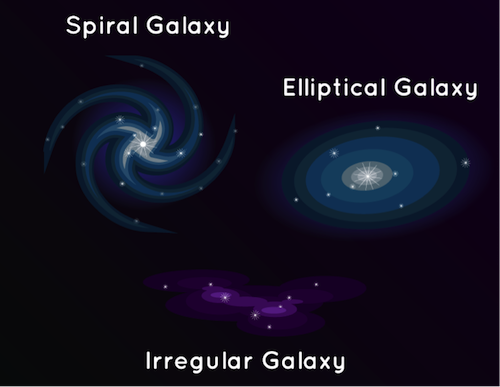
Past, Present, and Future of Space Travel: Sputnik and the Space Race
On October 4th, 1957 the Soviet Union successfully launched Sputnik, the world’s first artificial satellite, into Earth’s orbit. This successful launch of Sputnik sparked the Space Race between the Soviet Union and the United States. These two countries competed to get the first human to land on the Moon.
On January 31, 1958, the United States launched Explorer 1, a satellite that discovered the magnetic radiation belts around Earth. That same year, the United States created the National Aeronautics and Space Administration (NASA). In 1959, the Soviet Union launched Luna 2, the first spacecraft to land on the Moon. In April 1961, the Soviet astronaut Yuri Gagarin became the first person in space when he orbited Earth. Shortly after, astronaut Alan Shepard became the first American in space in May 1961.
The Space Race heated up and President John F. Kennedy claimed that the United States would put a man on the Moon before the end of the decade. In 1962, American astronaut John Glenn successfully orbited the Earth. In 1968, American mission Apollo 8 orbited the Moon. Finally, in 1969, the American mission Apollo 11 successfully landed the first two people on the Moon: astronauts Neil Armstrong and Buzz Aldrin.

Interesting Fact
Dr. James Van Allen from the University of Iowa created the radiation detector that launched on the Explorer 1 satellite. This led to the discovery of magnetic radiation belts around Earth which are known as Van Allen radiation belts in his honor. Van Allen Hall on Iowa’s campus is also named after him.
Women and Space
Traditionally, the story of the Space Race features male scientists and astronauts. However, women have played a key role in the history of American space exploration. NASA mathematicians Katherine Johnson and Dorothy Vaughan along with engineer Mary Jackson were key members of the team that launched John Glenn into space in 1962. In addition to this mission, these women had long careers at NASA. Their stories have recently been popularized in the movie Hidden Figures.
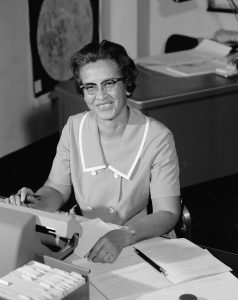
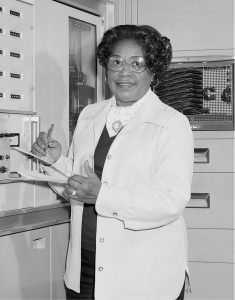
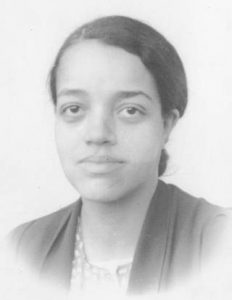
Initially, women were seen to have a physical advantage as astronauts; they tend to be lighter, shorter, and consume less food. In 1960, astronaut Jerrie Cobb had logged twice as many flying hours as John Glenn. But NASA made a requirement that astronauts had to be military pilots, a job only men could have. A group of 13 female astronauts, including Cobb, was gathered and subjected to the same tests as the male astronauts. The women passed all of the tests, and in many cases, performed better than the men. Still, NASA refused to support the female astronauts. In 1983, Sally Ride became the first female astronaut in space.


Black Holes
A black hole is an area in space with extremely strong gravity from which no light can escape. Thus, the area appears black. At the end of its lifecycle, a supermassive star collapses in on itself which causes a huge explosion called a supernova; this results in the formation of a black hole.
Seen below, scientists captured the first image of a black hole in 2019 using powerful telescopes.

Since black holes trap all light inside, the dark spot in the center of the image is the black hole’s shadow surrounded by a ring of glowing gas in space. Based on this image, scientists were able to determine that the this black hole’s mass is 6.5 billion times larger than the mass of our Sun.
Interesting Fact
Katie Bouman, a female graduate student at MIT, led the creation of the computer algorithm that made it possible to get this first image of a black hole.
For more explanation of black holes, watch the following video.
Video credit: “What is a Black Hole?” by NASA Space Place is public domain
NGSS
Performance Expectations
| 5-ESS1-1. | Support an argument that differences in the apparent brightness of the sun compared to other stars is due to their relative distances from the Earth. [Assessment Boundary: Assessment is limited to relative distances, not sizes, of stars. Assessment does not include other factors that affect apparent brightness (such as stellar masses, age, stage).] |
|---|
| MS-ESS1-2. | Develop and use a model to describe the role of gravity in the motions within galaxies and the solar system. [Clarification Statement: Emphasis for the model is on gravity as the force that holds together the solar system and Milky Way galaxy and controls orbital motions within them. Examples of models can be physical (such as the analogy of distance along a football field or computer visualizations of elliptical orbits) or conceptual (such as mathematical proportions relative to the size of familiar objects such as students’ school or state).] [Assessment Boundary: Assessment does not include Kepler’s Laws of orbital motion or the apparent retrograde motion of the planets as viewed from Earth.] |
|---|
| MS-ESS1-3. | Analyze and interpret data to determine scale properties of objects in the solar system. [Clarification Statement: Emphasis is on the analysis of data from Earth-based instruments, space-based telescopes, and spacecraft to determine similarities and differences among solar system objects. Examples of scale properties include the sizes of an object’s layers (such as crust and atmosphere), surface features (such as volcanoes), and orbital radius. Examples of data include statistical information, drawings and photographs, and models.] [Assessment Boundary: Assessment does not include recalling facts about properties of the planets and other solar system bodies.] |
|---|
DCI
fifth grade
ESS1.A: The Universe and its Stars
middle school
ESS1.A: The Universe and Its Stars
- Patterns of the apparent motion of the sun, the moon, and stars in the sky can be observed, described, predicted, and explained with models. (MS-ESS1-1)
- Earth and its solar system are part of the Milky Way galaxy, which is one of many galaxies in the universe. (MS-ESS1-2)
ESS1.B: Earth and the Solar System
- The solar system consists of the sun and a collection of objects, including planets, their moons, and asteroids that are held in orbit around the sun by its gravitational pull on them. (MS-ESS1-2),(MS-ESS1-3)
- The solar system appears to have formed from a disk of dust and gas, drawn together by gravity. (MS-ESS1-2)
Crosscutting Concepts
Scale, Proportion, and Quantity
Patterns
Scale, Proportion, and Quantity
middle school
Systems and System Models
– – – – – – – – – – – – – – – – – – – – – – – – – – –
Scientific theory for how the universe was created.
A cloud of gas and dust in space.
The process by which stars get their energy. Atoms fuse together creating a nuclear reaction which releases energy in the form of heat and light in the star.
Phase in a star's life cycle where it greatly increases in size as it burns fuel through nuclear fusion.
The giant explosion of a supermassive star at the end of its life cycle.
An area in space with extremely strong gravity from which no light can escape.
The disk-shaped plane in which everything in our solar system orbits around the Sun.
The innermost layers of Earth; made of a liquid outer core and a solid inner core.
The middle layer of Earth between the crust and the core.
The outermost layer of Earth.
Depression formed by an impact.
A meteoroid that survives its trip through the atmosphere and lands somewhere on Earth. The impact of a meteorite can cause a crater on the surface of a planet.
Rocky celestial bodies left over from the formation of the solar system that are smaller than planets and orbit the Sun.
Process by which broken down rocks are carried to a new location.
A collection of billions of stars, gas, and dust held together by gravity in space.
Our Sun and all of the planets and other bodies in space (comets, asteroids, meteoroids) that orbit around the Sun in the plane of the ecliptic.

